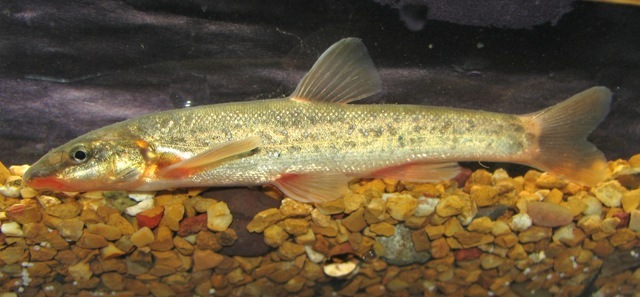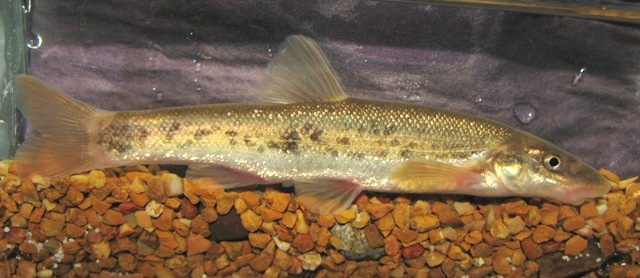Longnose Dace
(Rhinichthys cataractae)


Longnose dace are found in areas of extremely swift currents and have a streamline body built for dealing with such swift currents. Females (right) lack the red or orange lips, edge of gills, and bases of fins that males (left) have.
Description
Longnose dace have a long snout that projects well beyond the tip of the lower jaw resulting in a sub-terminal (below straight forward facing) mouth. They also have a rather long and streamline body and like other species of dace have very small scales giving them the appearance of having none at all. They are olive to dark brown above with black blotches, lighter brown colored sides, and a cream colored belly. They have two light colored spots at the front and back base of the dorsal fin which are visible when looking down on the fish. Males have red or orange flushed lips, rear edge of gills, and base of all their lower fins. The two light spots by the base of the dorsal fin are also often red or orange on males. They differ from the closely related western blacknose dace by having a longer snout, smaller eye, and no distinct lateral stripe.
Habitat and Habits
Longnose dace are found in rocky streams with extremely steep gradients and very swift currents. They can also be found in large lakes with rocky wave swept shorelines. In Ohio they are found in small streams in the Chagrin River watershed, a few other small eastern Lake Erie tributaries, and in several small streams draining into the upper Ohio River along the eastern edge of the state. In these streams they are found in the swiftest flowing rocky riffles. They can also be found along rocky wave swept shorelines of eastern Lake Erie. Here they are only found during the colder months of the year and it is suspected they migrate to deeper waters during summer.
Reproduction and Care of the Young
Longnose dace spawn during spring in very fast riffles over shallow gravel. Most spawn at two years and live for three or four years of age. Unlike other species of dace the two Ohio Rhinichthys species do not spawn in the nests of larger minnow species.